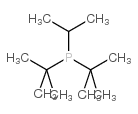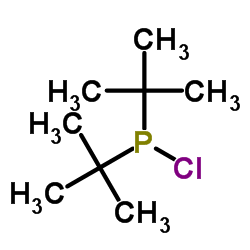Di-t-butyl(i-propyl)phosphine
Modify Date: 2024-01-11 18:01:58

Di-t-butyl(i-propyl)phosphine structure
|
Common Name | Di-t-butyl(i-propyl)phosphine | ||
|---|---|---|---|---|
| CAS Number | 25032-49-9 | Molecular Weight | 188.29000 | |
| Density | N/A | Boiling Point | N/A | |
| Molecular Formula | C11H25P | Melting Point | N/A | |
| MSDS | N/A | Flash Point | N/A | |
| Name | ditert-butyl(propan-2-yl)phosphane |
|---|---|
| Synonym | More Synonyms |
| Molecular Formula | C11H25P |
|---|---|
| Molecular Weight | 188.29000 |
| Exact Mass | 188.16900 |
| PSA | 13.59000 |
| LogP | 4.47370 |
|
Section 1: Product Identification Chemical Name:Di-t-butyl(i-propyl)phosphine, min. 98% CAS Registry Number:25032-49-9 Formula:C11H25P EINECS Number:none Chemical Family:organophosphine ligand Synonym:Bis-tert-butyl(isopropyl)phosphane
Section 2: Composition and Information on Ingredients IngredientCAS NumberPercentACGIH (TWA)OSHA (PEL) Title compound25032-49-9100%no datano data Section 3: Hazards Identification Emergency Overview:Harmful by inhalation, in contact with skin and if swallowed. Irritating to skin, eyes and respiratory tract. Primary Routes of Exposure:Ingestion, inhalation, skin, eyes Eye Contact:Causes mild to severe irritation of the eyes. Skin Contact:Harmful in contact with skin. Causes mild irritation or thermal burns if ignited. Inhalation:Harmful by inhalation. Irritating to the nose, mucous membranes and respiratory tract. Ingestion:Harmful if swallowed. May cause vomiting and diarrhea. Acute Health Affects:Harmful by inhalation, in contact with skin and if swallowed. Irritating to skin, eyes and respiratory tract. Chronic Health Affects:No information on long-term chronic effects. NTP:No IARC:No OSHA:No SECTION 4: First Aid Measures Immediately flush the eyes with copious amounts of water for at least 10-15 minutes. A victim may need Eye Exposure: assistance in keeping their eye lids open. Get immediate medical attention. Wash the affected area with water. Remove contaminated clothes if necessary. Seek medical assistance if Skin Exposure: irritation persists. Remove the victim to fresh air. Closely monitor the victim for signs of respiratory problems, such as difficulty Inhalation: in breathing, coughing, wheezing, or pain. In such cases seek immediate medical assistance. Seek medical attention immediately. Keep the victim calm. Give the victim water (only if conscious). Induce Ingestion: vomiting only if directed by medical personnel. SECTION 5: Fire Fighting Measures Flash Point:pyrophoric Autoignition Temperature:no data Explosion Limits:pyrophoric Extinguishing Medium:carbon dioxide, dry powder or foam If this product is involved in a fire, fire fighters should be equipped with a NIOSH approved positive pressure Special Fire Fighting Procedures: self-contained breathing apparatus and full protective clothing. Hazardous Combustion andIf involved in a fire this material may emit toxic organic fumes and phosphorus pentoxide. Decomposion Products: Unusual Fire or Explosion Hazards: Spontaneously flammable in air. SECTION 6: Accidental Release Measures This material may ignite spontaneously in air. Burning material may release toxic fumes. In case of poor Spill and Leak Procedures:ventilation, leave the area unless fitted with a self-contained breathing apparatus. Small spills can be mixed with ground limestone, sodium bicarbonate or other suitable adsorbents, swept up and held in a closed metal can. SECTION 7: Handling and Storage Store in a tightly sealed container under an inert atmosphere of nitrogen or argon. Keep away from heat. Handling and Storage:Material should be transferred under an inert atmosphere of nitrogen or argon in an efficient fume hood. Fire may occur in empty container and transfer lines. SECTION 8: Exposure Controls and Personal Protection Eye Protection:Always wear approved safety glasses when handling a chemical substance in the laboratory. Skin Protection:Wear protective clothing and gloves. Ventilation:Handle the material in an efficient fume hood. If ventilation is not available a respirator should be worn. The use of respirators requires a Respirator Respirator: Protection Program to be in compliance with 29 CFR 1910.134. Ventilation:Handle the material in an efficient fume hood. Additional Protection:No additional protection required. SECTION 9: Physical and Chemical Properties Color and Form:colorless liq. Molecular Weight:118.29 Melting Point:no data Boiling Point:no data Vapor Pressure:no data Specific Gravity:no data Odor:stench Solubility in Water:insoluble SECTION 10: Stability and Reactivity Stability:air-sensitive, pyrophoric liquid Hazardous Polymerization:no hazardous polymerization Conditions to Avoid:Contact with air. Material may spontaneously ignite. Incompatibility:oxidizing agents, halogens, air, halocarbons. Decomposition Products:carbon monoxide, carbon dioxide, phosphorus oxides and organic fumes. SECTION 11: Toxicological Information RTECS Data:No information available in the RTECS files. Carcinogenic Effects:no data available Mutagenic Effects:no data available Tetratogenic Effects:no data available SECTION 12: Ecological Information Ecological Information:No information available SECTION 13: Disposal Considerations Disposal:Dispose of according to local, state and federal regulations. SECTION 14: Transportation Shipping Name (CFR):Pyrophoric liquid, Organic, N.O.S. Hazard Class (CFR):4.2 Additional Hazard Class (CFR):NA Packaging Group (CFR):I UN ID Number (CFR):UN# 2845 Shipping Name (IATA):Forbidden Hazard Class (IATA):NA Additional Hazard Class (IATA):NA Packaging Group (IATA):NA UN ID Number (IATA):NA SECTION 15: Regulatory Information TSCA:Not listed in the TSCA inventory SARA (Title 313):Title compound not listed Second Ingredient:none SECTION 16 - ADDITIONAL INFORMATION N/A |
|
~91% 
Di-t-butyl(i-pr... CAS#:25032-49-9 |
| Literature: HOKKO CHEMICAL INDUSTRY CO. LTD. Patent: EP1473297 A1, 2004 ; Location in patent: Page 21 ; |
|
~% 
Di-t-butyl(i-pr... CAS#:25032-49-9 |
| Literature: Schmidbaur, Hubert; Blaschke, Guenther; Zimmer-Gasser, Beate; Schubert, Ulrich Chemische Berichte, 1980 , vol. 113, # 4 p. 1612 - 1622 |
| Precursor 3 | |
|---|---|
| DownStream 0 | |
| di-tert-butylisopropylphosphine |
| di-t-butylisopropylphosphine |
| Phosphine,di-tert-butylisopropyl |


